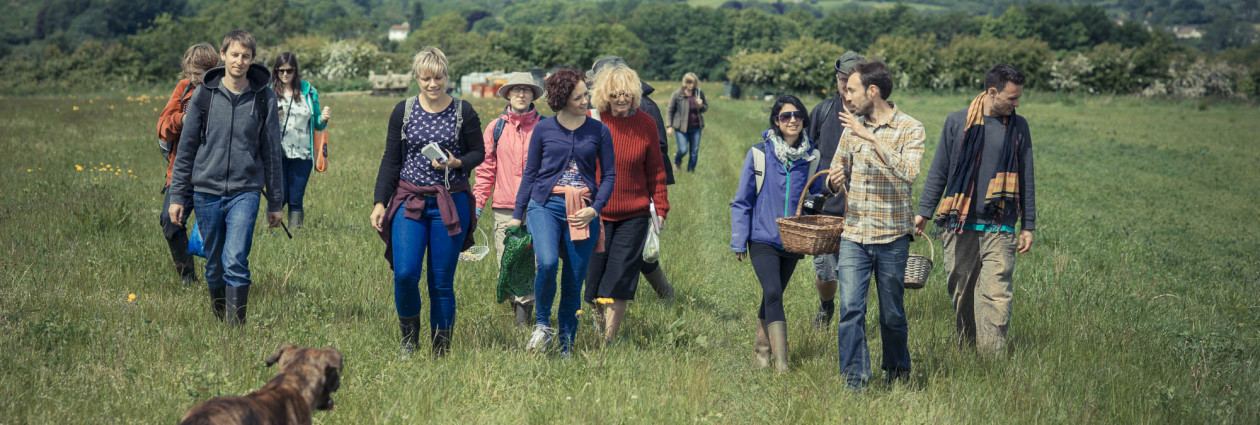Outside my window there are fresh fox trails in deep snow. It’s surely Winter time still, and yet there is a sense of rising energy as ideas and visions begin to manifest. Preparations must be made for the year ahead. Buds are forming on trees and the birds call forth the season’s change.
The natural world can appear quite barren at this time. My years of conditioning certainly had me believe that this is so. As such, on Winter walks I’d cast only a cursory glance at the carpet of debris beneath me. I’d pass by the skeletal remains of glorious umbels on stalks towering high above the leaf litter, perhaps pausing momentarily to admire their beauty. Now to me these hollow structures serve as messengers whispering the promise of new life and tender young edible shoots.
Foraging for food, getting to know plants intimately throughout the seasons, has led me to experience the world differently. Looking for, often very subtle clues in nature, I’ve learned to view things on the micro as well as macro scale. Regularly foraging and consuming wild food you can’t help but become more attuned to your environment. This simple act is quite profound in the way it connects us with the earth, giving a sense of being rooted in the place we live.
As I walk my breathing deepens and gradually I come to my senses. Thoughts quieten and my being expands to meet the surrounding landscape. I am drawn this way and that, until finally my feet come to a standstill. I am not sure why but it feels like this is the place to be right now. Then my attention is brought to a plant or mushroom and there’s a sense of magic and aliveness as we meet.
Next follows a spark of inspiration for some wild food creation – A soup, salad, herbal infusion, tincture or perhaps a seasonal ferment.
Fermenting and wild food really go hand in hand. The freshest leaves, shoots and bulbs are carefully selected and foraged. All this goodness is then not only preserved but is miraculously transformed by bacteria, fungi and the enzymes they produce during the fermentation process. Minerals become more bio-available, nutrients are enhanced and complex, wonderful flavors develop.
Our job is to set up the right conditions for this transformation to take place. We are invited to slow down, let go of the desire to be in control and “touch the process” – To listen to the environment, taste as we go, adding a little of this and a little of that, a pinch of salt at a time. It’s alchemy and requires a high degree of presence, of feeling into what is needed in each moment. Fermenting is more of an art than a series of rules to be followed and every time the set of circumstances is completely unique.
Over the coming weeks, nature’s wild offerings may include hairy bitter cress (neither hairy nor bitter!), alexanders, winter cress, jack by the hedge, wild garlic shoots, cleavers, black mustard and crow garlic.
A seasonal Winter kraut.
Several handfuls of black mustard leaves
One white cabbage
Two teaspoons of cumin seeds
Two beetroots sliced thinly and evenly
Approximately one tablespoon of sea salt
A winter meets spring ferment.
A few handfuls of crunchy wild garlic stems and leaves
One white cabbage
A small jar of pink peppercorns in brine
Approximately one tablespoon of sea salt
Basic kraut method
Wash and chop your ingredients then place in a large mixing bowl. Add a little salt and mix the contents with your hands. Taste to see if more salt is required. Carry on gradually adding and mixing like this until it tastes about right – Salty but not unpalatable. There needs to be enough salt to prevent aerobic fermentation by airborne bacteria.
Next, leave ingredients for 20 minutes or so, during which time the salt will start to bring out the juices from the vegetables. Massage them to further help this action, then transfer into a large, wide necked jar (sterilised).
Push contents down as much as possible using your hands or a rolling pin then place a weight, such as a jar filled with water with the lid on, inside your main jar. This is to weigh the vegetables down so that they will become submerged in salty brine.
Once fermentation starts taking place (usually after a day or so) the brine level will rise to cover your vegetables. If after a few days this hasn’t happened you can add a little mineral water to bring the level up. It’s worth placing a tray or saucer under the jar as there may be some overflowing.
Sample the kraut regularly and when it tastes good to you (probably after around a week) remove the weight, pop a lid on the jar and store in the fridge. It will keep for weeks or even months.
A precautionary note: Only pick and consume wild plants if you are one hundred percent certain you can positively identify them. Also, with any new food, air on the side of caution, trying only a small quantity to begin with.
By Martin Bailey
